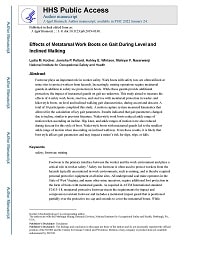Mining Publication: Effects of Metatarsal Work Boots on Gait During Level and Inclined Walking
Original creation date: July 2020
Authors: L Kocher, J Pollard, A Whitson, M Nasarwanji
Footwear plays an important role in worker safety. Work boots with safety toes are often utilized at mine sites to protect workers from hazards. Increasingly, mining operations require metatarsal guards in addition to safety toe protection in boots. While these guards provide additional protection, the impact of metatarsal guards on gait are unknown. This study aimed to measure the effects of 4 safety work boots, steel toe, and steel toe with metatarsal protection in wader- and hiker-style boots, on level and inclined walking gait characteristics, during ascent and descent. A total of 10 participants completed this study. A motion capture system measured kinematics that allowed for the calculation of key gait parameters. Results indicated that gait parameters changed due to incline, similar to previous literature. Wader-style work boots reduced ankle range of motion when ascending an incline. Hip, knee, and ankle ranges of motion were also reduced during descent for this style of boot. Wader-style boots with metatarsal guards led to the smallest ankle range of motion when descending an inclined walkway. From these results, it is likely that boot style affects gait parameters and may impact a miner’s risk for slips, trips, or falls.

- Infographic: Inspect Your Boots for Signs of Wear
- Investigation of a Slip/Fall Accident
- Method for Measuring Wear on Boot Outsoles Using a 3D Laser Scanner
- Musculoskeletal Stress on Miners Performing Roof Screening Operations
- Physical Strength Assessment in Ergonomics
- Self-Reported Musculoskeletal Symptoms Among Operators of Heavy Construction Equipment
- Slip, Trip, and Fall Hazard Identification, Investigation, and Remediation at Surface Mining Facilities
- Strength Testing
- Visual Performance for Trip Hazard Detection When Using Incandescent and LED Miner Cap Lamps
- When Work Boots Wear Out